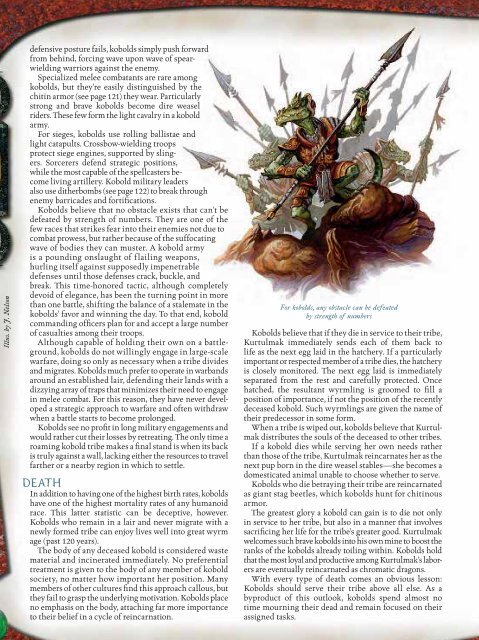Races of the Dragon.pdf - The Techno Jesus
Races of the Dragon.pdf - The Techno Jesus
Races of the Dragon.pdf - The Techno Jesus
You also want an ePaper? Increase the reach of your titles
YUMPU automatically turns print PDFs into web optimized ePapers that Google loves.
CHAPTER 3<br />
KOBOLDS<br />
44<br />
Illus. by J. Nelson<br />
defensive posture fails, kobolds simply push forward<br />
from behind, forcing wave upon wave <strong>of</strong> spearwielding<br />
warriors against <strong>the</strong> enemy.<br />
Specialized melee combatants are rare among<br />
kobolds, but <strong>the</strong>y’re easily distinguished by <strong>the</strong><br />
chitin armor (see page 121) <strong>the</strong>y wear. Particularly<br />
strong and brave kobolds become dire weasel<br />
riders. <strong>The</strong>se few form <strong>the</strong> light cavalry in a kobold<br />
army.<br />
For sieges, kobolds use rolling ballistae and<br />
light catapults. Crossbow-wielding troops<br />
protect siege engines, supported by slingers.<br />
Sorcerers defend strategic positions,<br />
while <strong>the</strong> most capable <strong>of</strong> <strong>the</strong> spellcasters become<br />
living artillery. Kobold military leaders<br />
also use di<strong>the</strong>rbombs (see page 122) to break through<br />
enemy barricades and fortifi cations.<br />
Kobolds believe that no obstacle exists that can’t be<br />
defeated by strength <strong>of</strong> numbers. <strong>The</strong>y are one <strong>of</strong> <strong>the</strong><br />
few races that strikes fear into <strong>the</strong>ir enemies not due to<br />
combat prowess, but ra<strong>the</strong>r because <strong>of</strong> <strong>the</strong> suffocating<br />
wave <strong>of</strong> bodies <strong>the</strong>y can muster. A kobold army<br />
is a pounding onslaught <strong>of</strong> flailing weapons,<br />
hurling itself against supposedly impenetrable<br />
defenses until those defenses crack, buckle, and<br />
break. This time-honored tactic, although completely<br />
devoid <strong>of</strong> elegance, has been <strong>the</strong> turning point in more<br />
than one battle, shifting <strong>the</strong> balance <strong>of</strong> a stalemate in <strong>the</strong><br />
kobolds’ favor and winning <strong>the</strong> day. To that end, kobold<br />
commanding <strong>of</strong>fi cers plan for and accept a large number<br />
<strong>of</strong> casualties among <strong>the</strong>ir troops.<br />
Although capable <strong>of</strong> holding <strong>the</strong>ir own on a battleground,<br />
kobolds do not willingly engage in large-scale<br />
warfare, doing so only as necessary when a tribe divides<br />
and migrates. Kobolds much prefer to operate in warbands<br />
around an established lair, defending <strong>the</strong>ir lands with a<br />
dizzying array <strong>of</strong> traps that minimizes <strong>the</strong>ir need to engage<br />
in melee combat. For this reason, <strong>the</strong>y have never developed<br />
a strategic approach to warfare and <strong>of</strong>ten withdraw<br />
when a battle starts to become prolonged.<br />
Kobolds see no pr<strong>of</strong>i t in long military engagements and<br />
would ra<strong>the</strong>r cut <strong>the</strong>ir losses by retreating. <strong>The</strong> only time a<br />
roaming kobold tribe makes a fi nal stand is when its back<br />
is truly against a wall, lacking ei<strong>the</strong>r <strong>the</strong> resources to travel<br />
far<strong>the</strong>r or a nearby region in which to settle.<br />
DEATH<br />
In addition to having one <strong>of</strong> <strong>the</strong> highest birth rates, kobolds<br />
have one <strong>of</strong> <strong>the</strong> highest mortality rates <strong>of</strong> any humanoid<br />
race. This latter statistic can be deceptive, however.<br />
Kobolds who remain in a lair and never migrate with a<br />
newly formed tribe can enjoy lives well into great wyrm<br />
age (past 120 years).<br />
<strong>The</strong> body <strong>of</strong> any deceased kobold is considered waste<br />
material and incinerated immediately. No preferential<br />
treatment is given to <strong>the</strong> body <strong>of</strong> any member <strong>of</strong> kobold<br />
society, no matter how important her position. Many<br />
members <strong>of</strong> o<strong>the</strong>r cultures fi nd this approach callous, but<br />
<strong>the</strong>y fail to grasp <strong>the</strong> underlying motivation. Kobolds place<br />
no emphasis on <strong>the</strong> body, attaching far more importance<br />
to <strong>the</strong>ir belief in a cycle <strong>of</strong> reincarnation.<br />
For kobolds, any obstacle can be defeated<br />
by strength <strong>of</strong> numbers<br />
Kobolds believe that if <strong>the</strong>y die in service to <strong>the</strong>ir tribe,<br />
Kurtulmak immediately sends each <strong>of</strong> <strong>the</strong>m back to<br />
life as <strong>the</strong> next egg laid in <strong>the</strong> hatchery. If a particularly<br />
important or respected member <strong>of</strong> a tribe dies, <strong>the</strong> hatchery<br />
is closely monitored. <strong>The</strong> next egg laid is immediately<br />
separated from <strong>the</strong> rest and carefully protected. Once<br />
hatched, <strong>the</strong> resultant wyrmling is groomed to fi ll a<br />
position <strong>of</strong> importance, if not <strong>the</strong> position <strong>of</strong> <strong>the</strong> recently<br />
deceased kobold. Such wyrmlings are given <strong>the</strong> name <strong>of</strong><br />
<strong>the</strong>ir predecessor in some form.<br />
When a tribe is wiped out, kobolds believe that Kurtulmak<br />
distributes <strong>the</strong> souls <strong>of</strong> <strong>the</strong> deceased to o<strong>the</strong>r tribes.<br />
If a kobold dies while serving her own needs ra<strong>the</strong>r<br />
than those <strong>of</strong> <strong>the</strong> tribe, Kurtulmak reincarnates her as <strong>the</strong><br />
next pup born in <strong>the</strong> dire weasel stables—she becomes a<br />
domesticated animal unable to choose whe<strong>the</strong>r to serve.<br />
Kobolds who die betraying <strong>the</strong>ir tribe are reincarnated<br />
as giant stag beetles, which kobolds hunt for chitinous<br />
armor.<br />
<strong>The</strong> greatest glory a kobold can gain is to die not only<br />
in service to her tribe, but also in a manner that involves<br />
sacrifi cing her life for <strong>the</strong> tribe’s greater good. Kurtulmak<br />
welcomes such brave kobolds into his own mine to boost <strong>the</strong><br />
ranks <strong>of</strong> <strong>the</strong> kobolds already toiling within. Kobolds hold<br />
that <strong>the</strong> most loyal and productive among Kurtulmak’s laborers<br />
are eventually reincarnated as chromatic dragons.<br />
With every type <strong>of</strong> death comes an obvious lesson:<br />
Kobolds should serve <strong>the</strong>ir tribe above all else. As a<br />
byproduct <strong>of</strong> this outlook, kobolds spend almost no<br />
time mourning <strong>the</strong>ir dead and remain focused on <strong>the</strong>ir<br />
assigned tasks.


